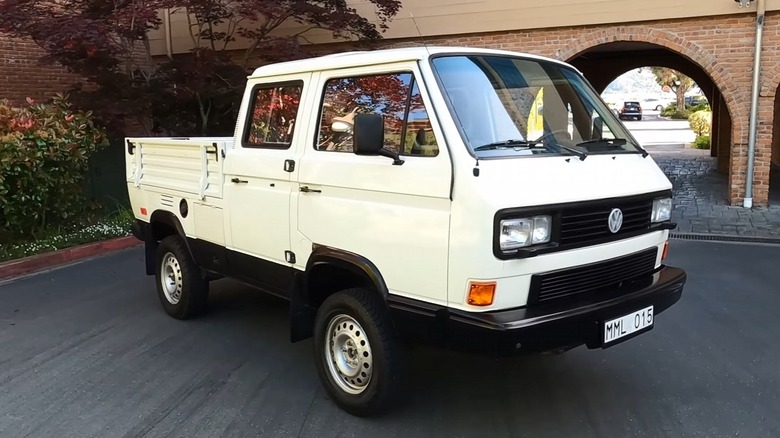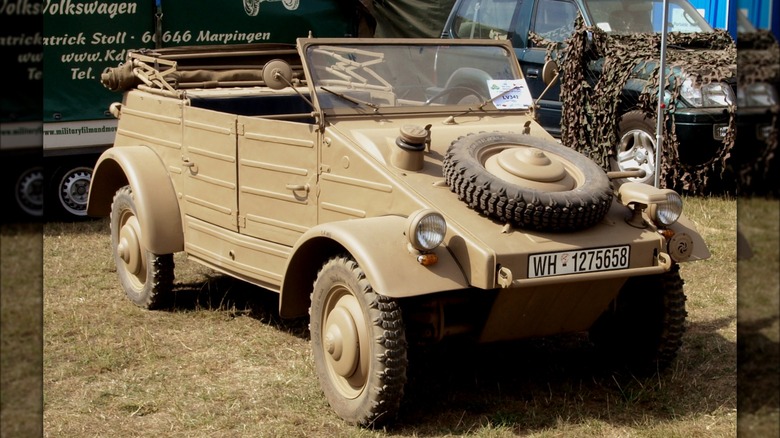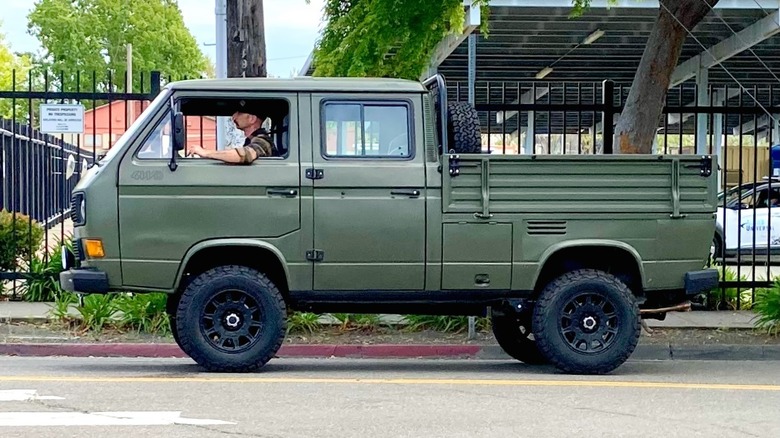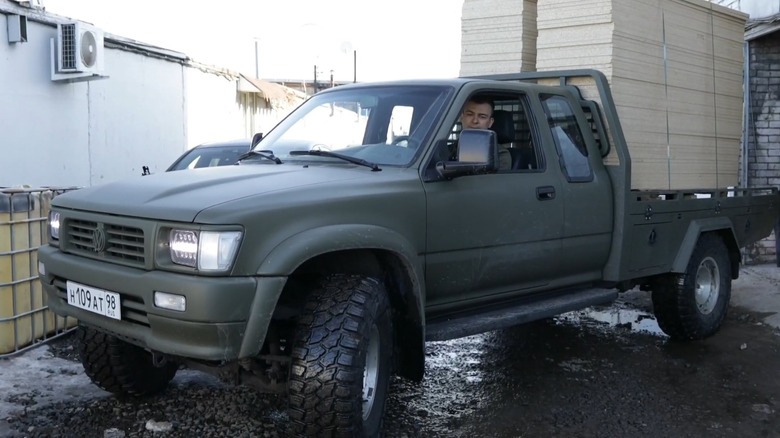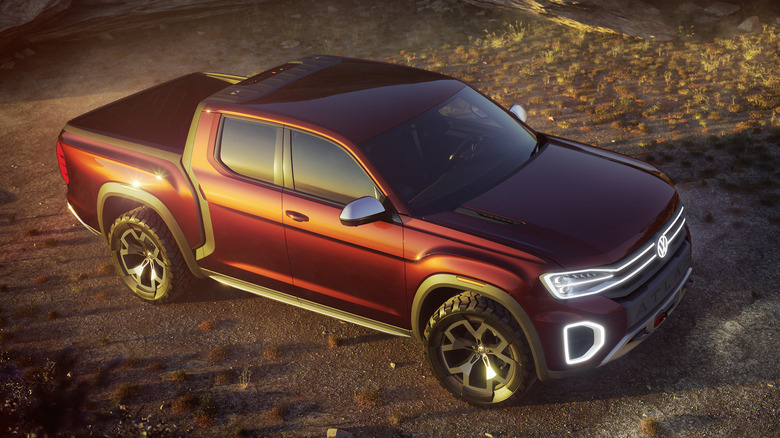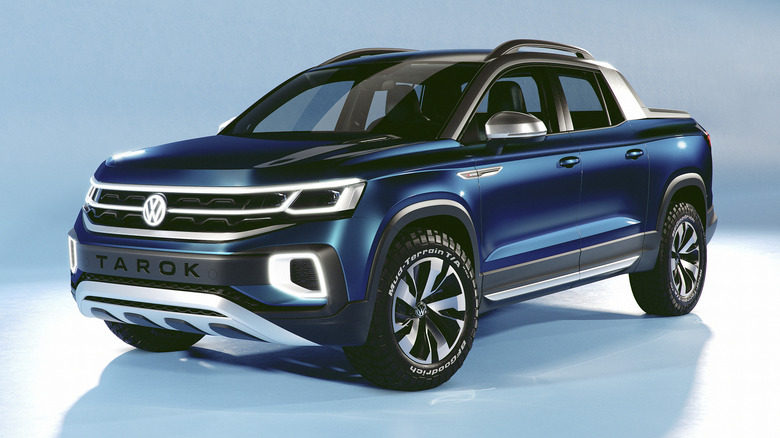12 Of The Best Looking Trucks VW Ever Designed
Volkswagen has built many classic vehicles over the years, whether it's the best-selling VW Golf, the iconic VW Beetle, or the classic hippie mobile that is the VW Bus. Of course, there's more to the German marque's offerings than these names, as deservedly well-known as they are. Despite likely being best-remembered for their campers and compact offerings, Volkswagen has also built a handful of trucks over the years — although precious few of them made their way to North America.
From early World War II-era light utility vehicles to chunky late-1980s crew cab pickups, the history of Volkswagen's trucks is an interesting, and often visually pleasing, one. Sure, not all of them fit squarely into the realms of the bonafide pickup truck — you'll want to check out Toyota's offerings for that — but we think they're all well worth learning about and appreciating, even if some are somewhat unique, to put it mildly.
We've also included a few concept trucks from the 2010s, because they're just too cool to not talk about, although you might be disappointed that none of them never made it to market.
Volkswagen Kübelwagen (1940 - 1945)
Volkswagen's World War II-era mlitary light utility vehicle, the Type 82 Kübelwagen, was essentially the German equivalent of the Willys Jeep. Rugged, simple, and ubiquitous, the Type 82 was another one of Ferdinand Porsche's creations – in fact, development of the KdF-Wagen and the VW Beetle was concurrent. Porsche realized that the original underpinnings weren't strong enough for military use, so he made some mechanical modifications and roped in German coachbuilder Trutz to design the bodywork.
For all of Porsche's mechanical triumphs — such as the drivetrain, which combined two-wheel-drive with a ZF locking differential for great off-road performance — the Type 82's most enduring characteristic is likely that Trutz-designed and built body. It's not necessarily what one would call pretty, but there's something about the angular profile, huge wheel arches, and ribbed bodywork that we — and many enthusiasts — find quite visually appealing. It's utilitarian, sure, but also surprisingly characterful.
Volkswagen built the Kübelwagen from 1940 to 1945, along with an amphibious variant called the Schwimmwagen. While the Kübelwagen didn't survive past the end of World War II, the body shape did. Volkswagen revived the body style for the oh-so-1970s The Thing. This unique VW had a brief two-year run in the U.S. in the mid-1970s before safety regulations put an end to it.
Volkswagen Plattenwagen (1946 - 1973)
The end of World War II put a stop to the productions of military vehicles like the Kübelwagen, but Volkswagen just kept trucking on in the immediate aftermath by continuing to build cars for occupation forces at its Wolfsburg plant. And that's where one of the company's most unique vehicles comes into the picture. Say hello to the Plattenwagen.
You may never have heard of the Plattenwagen, and there's a good reason why — VW didn't build it for public sale. Instead, VW designed the Plattenwagen for moving cargo and parts around its factory. To that end, the Plattenwagen was a purely functional vehicle, without much aesthetic design. Well, beyond its unique layout, that is. The Plattenwagen's load bed was in the front, ahead of its open cab — which was really just a couple of seats or a bench seat with controls and a windshield in front.
Now, we'll never try to convince you that the Plattenwagen was a beautiful truck. It's certainly not the former, and it's only barely an example of the latter. Still, as a mark of post-war ingenuity and unintentional quirkiness, it's hard to beat. The Plattenwagen is rugged and utterly no-frills, and that, we think, gives it a unique aura. Besides, there's always something about an exposed metal frame that just works.
[Image by Bundesstefan via Wikimedia Commons | Cropped and scaled | CC BY-SA 3.0]
Volkswagen Type 147/Fridolin (1964 - 1974)
Volkswagen's Fridolin – initially known as the Type 147 Kleinlieferwagen — was just as utilitarian a vehicle as the two predecessors we've discussed, but this mid-1960s vehicle had more to offer than a functional, all-business design. With its high-sided profile and pure '60s VW aesthetics, the Fridolin ranks as one of VW's prettiest trucks ever.
The Fridolin was essentially a mail truck that the German Postal Authority commissioned Volkswagen to build. The body set several criteria, including having 71 cubic feet of cargo space, a payload of between 770 to 880 pounds, and two sliding doors. So what did Volkswagen do? It combined a Karmann Ghia chassis with Beetle drivetrain, a Type 2 Microbus rear panels, and the headlights as well as the hood from the classic Type 3 Fastback to create a mail truck that was way more than the sum of its parts.
We love the Fridolin's angled sliding doors, subtly curvy lines, and just-right wheelbase, with the total effect feeling like a greatest hits collection of 1960s Volkswagen design. The tall roof was a bit of a departure, of course, even compared to the VW Buses of the day, but that just makes the Fridolin all that more special. However, it isn't just quirky — the Fridolin is also rare, with only around 200 of the 6,000 built between 1964 and 1974 still surviving.
Volkswagen Transporter T2 pickup (1968 - 1979)
If there's a signature VW vehicle after the Beetle, it's probably the Transporter, which continues to be a fixture of the company's lineup well into its eighth generation. While the new Transporters are all well and good, it's the immortal first- and second-generation Transporters that most of you will likely know and recognize — not least because of that iconic yellow VW Bus that starred in "Little Miss Sunshine."
The thing about the Transporter T2, though, is that Volkswagen built many more body styles for it than the passenger version the U.S. received. One such version — which never came to the U.S. due to the Chicken Tax, which adds a 25% tariff on imported light trucks and vans – is the T2 pickup. It's precisely what you would imagine when you see that combination of words — the classic cheerful Transporter T2 front, with two or three doors, but with a pickup bed where the rest of the interior would be.
Mechanically, the T2 Pickups were much the same as other T2s and the VW Bus that came to the U.S., with a 1.6-liter, air-cooled flat-four making 48 hp and a four-speed manual transmission. It's probably not all that different to drive, either. It is, after all, still a Transporter. However, we're talking about looks here, and the Transporter T2 pickup is a surefire winner there. It's not just us, either — Hot Wheels liked the T2 Pickup enough to immortalize it in die-cast form, too, albeit in a much racier guise.
Volkswagen EA489 Basistransporter/Hormiga (1975 - 1979)
If you thought that the Fridolin and T2 pickup of the 1960s meant that Volkswagen had left its angular and utilitarian days behind, you'd be wrong. However, as with its earliest trucks, Volkswagen's move to strip things back and offer nothing but the bare minimum with the 1975 EA489 Basistransporter ended up creating its own strange beauty.
Once again, the EA489 isn't a pretty truck in the conventional sense. Where offerings like the T2 and Fridolin sported softer lines and nice little touches, the EA489 was all straight angles with an almost brutalist design free of any fripperies or creature comforts, inside or out. It's simultaneously toy-like and po-faced, serious but also oddly funky, and we can't help but appreciate it for that. The EA489's ultra-minimalist approach wasn't some exercise in post-WWII torture, either — instead, the EA489 was built for emerging markets such as Mexico, which received a locally assembled version called the Hormiga.
The truck didn't prove all that popular in either guise, with only 6,200 built between 1975 to 1979 across both countries. While its rarity alone makes it a notable VW offering — at least, for the car nerds amongst you — the EA489/Hormiga is also worth remembering for having a front-mounted air-cooled engine with front-wheel-drive, a setup that Volkswagen only ever used in the Brazilian Volkswagen Gol from a few years later.
Volkswagen Rabbit Pickup (1979 - 1984)
American buyers may have missed out on the Transporter T2 pickup, but VW did bring one of its pickups to the U.S. in the next decade. It's not quite as beautiful as the T2, admittedly, but it has its charms. We're talking, of course, about the Volkswagen Rabbit Pickup.
The Rabbit was an American-built version of the first-generation Golf, albeit with changes such as an altered suspension, cheaper interior, and ugly black plastic bumpers. While these may have hurt the Rabbit's appeal as a compact car — at least compared to the Golf — Volkswagen eventually made good when it came up with the idea of the Rabbit Pickup.
After all, the softer suspension was probably precisely what a pickup truck needed, and what would have seemed cheap in a passenger car could likely be seen as a practical choice for a pickup. So the Rabbit Pickup, with its gasoline and diesel engines, hit the U.S. market in 1979. It wasn't fast, but it combined that ineffable sense of character so many early Volkswagens had with surprising practicality, thanks to its 1,100-pound load capacity. The Rabbit Pickup was such a great idea that Volkswagen brought it to Europe as the Caddy in 1983.
[Image by Jeffrey O. Gustafson via Wikimedia Commons | Cropped and scaled | CC BY-SA 3.0]
Volkswagen Transporter T3 Syncro pickup (1984 - 1992)
It probably isn't a surprise that Volkswagen continued offering a pickup variant for the third-generation Transporter T3 — better known as the Vanagon – in the U.S. While we have nothing against the standard T3 pickup, the version that we're highlighting here is the slightly later Syncro version, which first emerged in 1984.
The off-road-capable Syncro, which was a four-wheel-drive version of the T3 pickup, has a few traits that set it apart from the two-wheel-drive version and, in our estimation, make it the much more visually appealing truck. All Syncro Transporters have a higher ride height, which works perfectly with the T3 pickup's chunkier lines. We also like the perfectly 1980s Syncro and 4WD decals — a bit out of place on a utility vehicle, admittedly, but in a very pleasing way.
Like its predecessor, Volkswagen offered the T3 pickup in single- and dual-cab — also known as the Doka — configurations, although all the Sycncro pickups we've seen are the latter. Volkswagen stuck with the three-door design for the dual-cab front, too, which is perhaps a bit idiosyncratic still adds to the appeal. All in all, the total package — decals, higher ride, dual-cab, and gloriously boxy lines — makes the T3 Syncro pickup our favorite VW truck. An odd choice, perhaps, but slap some aftermarket wheels and knobby off-road tires on one and we think you'll see what we mean.
[Image by Bill Abbott via Flickr | Cropped and scaled | CC BY-SA 2.0]
Volkswagen Taro 4x4 (1989 - 1997)
You'd be forgiven for never having heard of the Taro before, especially if you live in the U.S. Like many of the German firm's trucks, the Taro was a truck for European and emerging markets in the 1990s, much like the EA489 Basistransporter and Hormiga had been in the late 1970s. However, the Taro wasn't quite as brutally simplistic as the EA489 and other prior Volkswagen trucks had been. In fact, the Taro technically wasn't even a Volkswagen at all.
Instead, the Taro was a fifth-generation Toyota Hilux with a Volkswagen badge on the front. The German-built Taro was announced as the product of a joint venture between VW and Toyota in 1989. Volkswagen needed a one-ton pickup to sell in Europe but couldn't afford to develop one. Toyota had a great pickup — the fifth-gen Hilux is arguably the best version of the truck — and wanted to establish itself in the European market. Thus, the Taro was born.
Volkswagen sold three versions of the Taro. The basic version came with a 1.8-liter engine and two-wheel-drive, while the larger-displacement 2.2- and 2.4-liter versions sported four-wheel drive. The four-wheel-drive versions are the best — they had higher ground clearance and flared-out wheel arches, giving the all-wheel-drive Taro a clean, muscular look. Sure, it's a Toyota underneath it all, but it's still one of the best trucks to ever carry the VW badge on the front grille.
Volkswagen Tristar concept (2014)
We've mostly been digging through Volkswagen's vintage offerings up until now, and for a good reason — classic Volkswagens just had more character to their design. Still, that doesn't mean the company's modern offerings are necessarily ugly, even if many of its best-looking trucks from the past decade or so have been concepts. Case in point is the Tristar concept from 2014.
The Tristar, which VW showcased at that year's IAA show, was a throwback to the T3 Doka pickup from the 1980s. The angled dual-cab-styled front was pure Doka, as were the knobby tires and chunky pickup bed. It looked tough and rugged in an old-school way, even if the orange paint and styling details were more 2014 than 1984. It nailed the balance, though, embracing what was then the future without losing sight of the past.
The Tristar had concept car gimmicks such as a video-conferencing system and built-in espresso machine, but neither detracted from how good the Tristar looked and still looks. VW also let the motoring press take the Tristar out for a spin, with at least one outlet expressing disappointment that VW didn't plan to build the Tristar. Sure, it's probably not as desirable a concept as VW's W12-powered Golf GTI, but it'd have been great to see it as a production vehicle nonetheless.
Volkswagen Atlas Tanoak concept (2018)
Volkswagen spent a chunk of the 2010s teasing various pickup concepts that would never hit the market. The Tristar may have kicked things off, but it was far from the last. Enter the Atlas Tanoak, a large midsize pickup concept that would have competed with Honda's Ridgeline had VW decided to build it for real.
VW based the Atlas Tanoak on its existing Atlas crossover and MQB platform, intending to share all the parts forward of the B-pillar to cut down on costs. Despite the shared DNA, the Atlas Tanoak took a radically different approach to the design, especially with the front fascia. VW went full-on with the LEDs here, with a full-width illuminated front grille-and-headlight combo and angular bumper lights. It wasn't the only highlight of the concept, but we think it was definitely the best part of the Atlas Tanoak.
Other cool design details were the flush door handles for the rear doors, flared and extended fenders, and integrated side marker lights on the front fender extensions. The Atlas Tanoak would have had the grunt to match its looks, too — VW specced a 276 hp, 3.6-liter V6 for the pickup, with an eight-speed transmission and four-wheel-drive transferring the V6's power to the road.
Volkswagen Tarok concept (2018)
The Atlas Tanoak concept remained just that, but Volkswagen cleverly decided not to let its designers' work go to waste. Instead, it also used the Atlas Tanoak's front end, with its chunky lines and copious LEDs, for a compact pickup concept called the Tarok.
Volkswagen unveiled the Tarok a few months after the Atlas Tanoak's 2018 debut, showcasing the four-door pickup at the São Paulo International Motor Show in November. The Tarok didn't just retain most of the frontal design language VW had first shown off with the Tanoak, either. The Tarok also kept the — admittedly less-aggressively — flared fenders and clean lines, but with a four-door body instead of the Tanoak's dual-cab.
The four-door made for a slightly less appealing profile, but the practicality was at least unaffected: the rear seats folded down, creating around 100 inches of space when needed. A 4Motion four-wheel-drive would come standard, as would VW's Digital Cockpit tech on the inside. Unlike the Atlas Tanoak, VW had concrete plans to put the Tarok into production, at least for the Brazilian market. Unfortunately, it never came out, with Volkswagen's Peter Schäfer telling Automotive News in 2022 that the pickup no longer featured in the company's plans.
Second-generation Volkswagen Amarok (2022)
Volkswagen hasn't put that much effort into the pickup market since the 1990s. Sure, it had the Taro for most of that decade, but it was just a rebadged Toyota Hilux. In contrast, the Tristar, Atlas Tanoak, and Tarok were great-looking trucks, but none ever made it beyond the concept phase. Still, there's actually one bonafide VW pickup, the second generation of which looks great to our eyes — the Amarok.
As with many of its trucks, Volkswagen built and marketed the first-generation Amarok for global, non-U.S. markets. Available in single- and dual-cab variants, the first-gen Amarok was a capable pickup that impressed reviewers who got to test one. While it was, by most accounts, a great utility vehicle, the first-gen Amarok wasn't much of a looker. It wasn't ugly, no, but it was a bit plain — and not in a good way.
That all changed with the second-generation Amarok, which VW unveiled in 2022. The fruit of a Ford-VW collaboration, the new Amarok is essentially a Ranger with a VW-designed body on top. We particularly like the front, which evokes the chunky design and LED rings of the Atlas Tanoak, albeit with less illumination. The rest of the body isn't quite as striking, but it's just right. The clean lines and stance are imposing, but not comedically so. So while it's not coming to the U.S., you could still buy a 2024 Ford Ranger instead.
